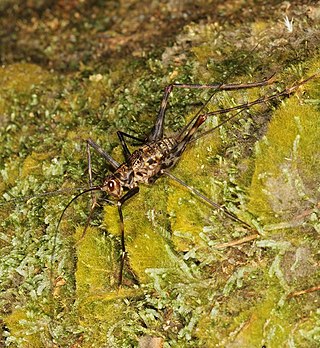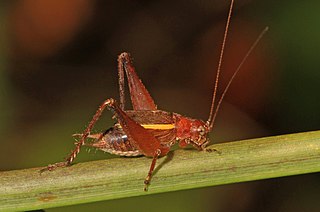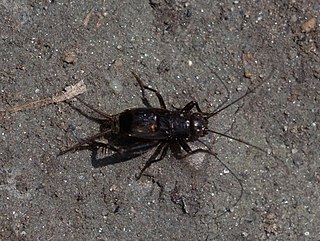
Tree crickets are insects of the order Orthoptera. These crickets are in the subfamily Oecanthinae of the family Gryllidae.

Cycloptilum is a genus of common scaly crickets in the family Mogoplistidae from the Americas. There are at least 50 described species in Cycloptilum.

Trigonidiinae is a subfamily of insects in the order Orthoptera, suborder Ensifera, based on the type genus Trigonidium. They are often referred to as sword-tail crickets, winged bush crickets or trigs.

Phalangopsinae, occasionally known as spider crickets, are a subfamily of crickets in the family Phalangopsidae. Members of Phalangopsinae are found worldwide in tropical and subtropical regions. Most species in the subfamily are nocturnal and can be found in rocky areas, near fallen wood, and the understory of forests. Some species are gregarious, gathering in large numbers.

The Eneopterinae are a subfamily of crickets, in the family Gryllidae, based on the type genus Eneoptera. It is one of several groups widely described as "true crickets". Of the more than 500 species that make up this subfamily, most occur in moist, tropical habitats. These insects are medium to large and brown or gray in color. They eat plant leaves, flowers, and fruits and can occasionally cause economic damage. Their eggs are deposited in pith, bark, or wood. Eneopterinae show a great diversity in stridulatory apparatus, signals emitted, and associated behaviour.

Anurogryllus, commonly known as short-tailed crickets, is a genus of crickets in the tribe Gryllini; species are recorded from the Americas. The common and scientific names derive from the vestigial, poorly developed ovipositors of females.

Hapithinae is a subfamily of insects in the cricket family Gryllidae. It is one of several groups referred to in American English as "bush crickets", although this term can be confused with the Tettigoniidae.

Cyrtoxipha columbiana, the Columbian trig, is a species of cricket in the family Trigonidiidae. It is endemic to most of the southeastern United States, up to New Jersey, although sightings are also reported from further north, including New York and Massachusetts.

Miogryllus is a genus of crickets in the subfamily Gryllinae, in the family Gryllidae and tribe Gryllini. Members of the genus Miogryllus are called striped crickets, also lesser field crickets. There are two North American species of Miogryllus, Miogryllus lineatus, the western striped cricket, and Miogryllus saussurei, the eastern striped cricket.

Gryllidea is an infraorder that includes crickets and similar insects in the order Orthoptera. There are two superfamilies, and more than 6,000 described species in Gryllidea.

Falcicula is a genus of winged bush crickets, or trigs, in the family Gryllidae, containing the single species Falcicula hebardi.

Phyllopalpus is a genus of winged bush crickets, trigs in the family Trigonidiidae. There are about six described species in Phyllopalpus.

Pentacentrinae is a subfamily of crickets in the family Gryllidae. Sometimes known as 'Silent Litter Crickets', they occur in tropical Asia, Africa and the Americas. The tribe Lissotrachelini Hubbell, 1938 has been moved to the Nemobiinae.

Tafalisca is a genus of silent bush crickets in the family Gryllidae. Records for described species in Tafalisca are mostly from Central and South America.

Podoscirtinae is a subfamily of crickets in the family Gryllidae.

Pteronemobius is a genus of crickets in the subfamily Nemobiinae, with a worldwide distribution.

Cladonotinae is a subfamily of groundhoppers containing more than 70 genera and 260 described species. These insects are found in tropical areas world-wide.

Hapithini is a tribe of crickets in the subfamily Hapithinae. There are about 12 genera and more than 260 described species: found in Central and South America.

Episactidae is a family of grasshoppers in the order Orthoptera. There are about 19 genera and more than 60 described species in Episactidae, found in Central and South America, China, and Madagascar.


















